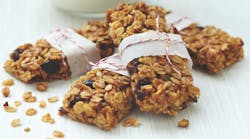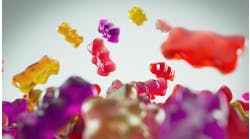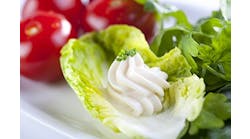Hydrocolloids play a giant role in food and beverage development. These ingredients can improve mouthfeel, viscosity, texture, stability, and countless other characteristics of processed foods.
Naturally, then, food processors choose their hydrocolloids carefully when creating new products, including the many “clean label” and “better-for-you” products now on the market.
Here’s the thing: Deciding which hydrocolloids accommodate a “clean label” and which don’t is not an exact science. In fact, science often plays an inferior role to perception.
“What is ‘clean label’? That’s the million-dollar question,” says Aaron Venables, manager for frozen desserts applications at DuPont Nutrition & Biosciences. “Different consumers have different perceptions of what that means.”
Iliana Nava, a senior technical service specialist at Cargill, concurs: “’Clean label’ is a very broad term and it can mean different things to different people.”
The science
Hydrocolloids are long-chain polymers that form viscous dispersions or gels when mixed with water. That’s the basic characteristic that makes hydrocolloids valuable to food and beverage processors, but there are unending variations to how hydrocolloids perform.
“Even though the various hydrocolloids belong to the same ingredient category, their individual properties can vary significantly,” says Olaf Kohnke, EMEA senior technical service manager for soups, sauces and dressings at Tate & Lyle. “For example, using the same dosage level of different sources and types of guar gum can provide a range of viscosities and different water binding capabilities. However, all are labeled as ‘guar gum’ in the ingredient declaration.”
And mixing hydrocolloids changes how they act.
“In addition to the properties of each individual hydrocolloid, there are also several synergistic effects among the different hydrocolloids,” Kohnke explains. “For example, xanthan gum and locust bean gum (also known as carob bean gum) individually create a unique viscosity in a water solution. However, using a combination of the two well-known hydrocolloids, you suddenly obtain a gel. These synergistic effects are complex and therefore, it can be challenging to find the optimum combination for every type of food.”
What is clean?
Because food processors call on hydrocolloids to do so much in so many combinations, it’s easy to see why they often turn to a variety of hydrocolloids to meet a particular need, which confuses the “clean” story.
Some hydrocolloids are intact natural ingredients, such as pectin, which is a polysaccharide found in fruit; and acacia, which is a gum that comes from the acacia tree. They easily fit on a clean label, not only because they are natural, but also because most consumers are reasonably familiar with the words.
Pectin is a gelling agent that also stabilizes dairy products, Venables explains. “It finds a lot of utility in the low pH dairy market to protect proteins. Pectin adheres itself to the outside surface of a protein, creating a smooth, stable product.”
Acacia, also called gum acacia, improves powdered beverages, says Matthew Berliner, vice president of ISC Gums. “Acacia is excellent at improving mouthfeel in beverages and masking harsh aftertastes of certain ingredients. Due to these characteristics, acacia is gaining popularity in powdered beverage applications where acacia will improve the mouthfeel, mask the unpleasant mouthfeel of ‘gritty’ ingredients and the cover the harsh aftertaste of some ingredients.”
Many other hydrocolloids begin as natural ingredients but are modified in some way. An example is modified starch, which is normal starch extracted from grains or vegetables that is chemically, enzymatically or physically altered to change its properties.
Even products carrying a natural claim may have a hydrocolloid – in this case, “vegetable gum” (tara).
“Some starches are chemically modified because people want them to provide different functionalities,” Nava says, “such as the ability to tolerate very high temperatures or high mixing speeds.”
In most cases, modified starch would not be considered a clean ingredient, even though there’s nothing inherently unhealthy about a modified starch.
But clean and not clean are not two camps on opposite sides of the lake; rather, cleanliness is on a spectrum, and some hydrocolloids closer to one side or the other might be perceived as cleaner or less clean than they really are.
Take carrageenan as an example. This hydrocolloid is extracted from seaweed and has been used for hundreds of years in natural cooking. It’s a gelling agent, but unlike gelatin, which comes from animal sources, it’s plant-based making it suitable for vegans.
“Carrageenan has taken a hit in the last six or seven years as an ‘unclean’ ingredient, but it’s 100 percent natural,” Venables says. “It took a hit because there were some independent studies done with bad science that claimed there were some health issues with carrageenan.
"We’ve done our own research and worked with the government to show how safe it actually is," he continues. "I just think there’s a small percentage of people with a big voice and they spread the word that carrageenan will give you cancer. Yet it is the one hydrocolloid allowed as a stabilizer in baby formula!”
And what about hydrocolloids that are biosynthesized, such as xanthan gum and gellan gum? Both originate as natural ingredients and become hydrocolloids through a fermentation process, but gellan gum is considered clean label and xanthan gum often is not. Why? Venables speculates that it’s because of its name.
“People don’t consider xanthan gum clean only because it has an X in front of it,” he says. “That just shows you how crazy it is. But we have to abide by the market.”
Good Foods’ Feta Cucumber Tzatziki Dip has pectin, carob bean, xanthan gum and guar gum for texture.
Xanthan gum is one of the hydrocolloids – together with konjac gum – found in Impossible Burgers from Impossible Foods.
Creating the clean label
As Venables and Nava note, “clean label” has several definitions, so creating a food product with a clean label requires choosing which definition applies to the product you’re making.
For example, for many people a clean label is a short label with familiar ingredients. That might mean removing ingredients that are not essential and replacing ingredients with long scientific names with more common ingredients that do the same thing.
“In terms of familiarity, there are a variety of hydrocolloids that people recognize,” Nava says. “Pectin is one. People have known pectin for a long time, it’s something you should find in your pantry.”
Pectin is a hydrocolloid found in Chobani Coconut Vanilla Non-Dairy Yogurt. That product also contains locust bean gum, another clean-label hydrocolloid.
Starches – at least those without the word “modified” in front of them -- are also familiar-sounding hydrocolloids. Nava says Cargill’s SimPure line of functional starches, including corn and potato starch, are label-friendly.
Beyond Burger from Beyond Meat contains potato starch, adding a clean characteristic to its rather long ingredient list. Another hydrocolloid in Beyond Burger is methylcellulose, which is synthesized by chemically altering plant cellulose and is not considered a clean-label ingredient.
Of course, another commonly understood characteristic of “clean label” is that the ingredients are considered healthy, whether they are pantry-familiar or not.
“Value-added characteristics such as organic, non-GMO, sustainable, etc., are in great demand,” says Berliner from ISC Gums. Gum acacia is a hydrocolloid that fits into that category. A home cook probably does not have a jar of gum acacia in his kitchen cabinet, but a little research reveals that it’s a natural, healthy ingredient.
“Gum acacia demand has greatly increased, because unlike modified food starches and other acacia replacements, acacia exhibits all of these clean-label characteristics,” Berliner says.
And finally, to some people a clean label is one that encompasses familiarity, health and societal and environmental issues.
“More than ‘clean label,’ today we see a trend toward ‘clean image,’ which encompasses sustainability, low sugar, low salt, plant-based, health and nutrition as well as products which do not negatively impact society or the environment,” says Tammy Reinhart, stabilization & functional systems global marketing director for Tate & Lyle.
How does a hydrocolloid meet all of those label demands? It’s a matter of careful sourcing, Reinhart asserts.
“Through our extensive ingredient expertise and raw material sourcing capabilities, we can help our customers tailor their formulation to fit the target consumers’ definition of ‘clean label,’ ” she says.
Consumers these days love their clean labels, especially when it comes to foods and beverages that purport to be better for them and the environment. Choosing the right hydrocolloid to achieve the desired result in the product and on the label requires a combination of understanding food science and understanding consumer perception.


